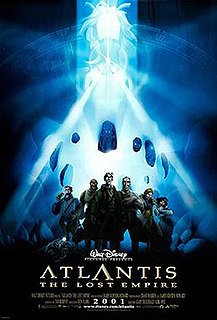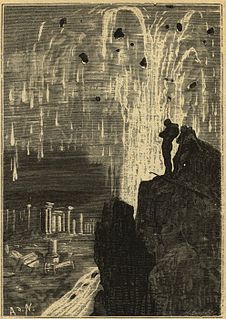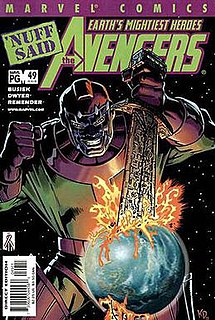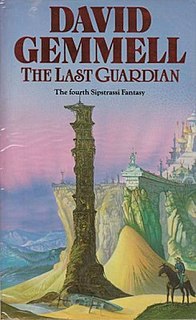Plot summary
The Avatars were immortal and lived like kings - even though their empire was dying. Their immortality was guaranteed by magic crystals, crystals whose influence was now waning. But when two moons appeared in the sky, and the ruthless armies of the Crystal Queen swarmed across the land, bringing devastation and terror, the Avatars united with their subjects to protect their universe.
The story is set in the world of the Avatars - an immortal race of humans, who are convinced that they are gods, undying. Their empire was destroyed when the seas upturned. A few - around 200 - escaped when one of the spiritual leaders, Questor Anu, predicted the fall of the world. The group of 200 moved north from the city of Parapolis, to the city of Pagaru. The day after they arrived, the world was turned upside down, and Questor Anu gained the title of The Holy One. Other than the group who travelled with Questor Anu, the Holy One, about 300 other Avatars survived the end of the world.
The Avatars rely upon magic crystals to keep them alive and healthy. Their power is fading, however, and an expedition attempts to recharge power chests by creating a link with their great power source within the previous capital city, Parapolis, which was covered in ice. They succeed - partly - charging four of the six chests. The chests are used to power the only Avatar ship, the Serpent Seven, as well as recharge the primary Avatar weapons - the zhi-bow. The zhi-bow is a bow that shoots the equivalent of plasma bolts.
The humans who are ruled by the Avatars, known as the Vagars, are starting a secret rebellion in the remaining cities of the Avatar. The group calls themselves the Pajists - a group set out to see the fall of the Avatar. The Pajists are a group of assassins who are headed by a Vagar woman known as Mejana. Mejana is motivated to bring down the Avatar Empire by the killing of her daughter, who disobeyed the race laws by falling in love with an Avatar. She was crystal-drawn, meaning that her life force was sucked out of her and into the crystals of the Avatar, which grant them immortality. Crystal drawing cannot be infinitely continued, however, so Anu the Holy One begins the construction of a great pyramid which will supposedly absorb the suns energy and then power the crystals of the Avatar. However, the real purpose behind the pyramid is to destroy all the Crystals, as Anu foresaw the arrival of foreign invaders, led by a great crystal power.
There are greater problems for the Avatar and the people with them, however. A people known as the Almecs, who are headed by Almeia, the Crystal Queen, managed to avoid the fall of their own world by teleporting their continent to the world of the Avatars. They learn of the Avatars, and their fragile position in the world. Thinking the Avatars will realize the obvious, they sail to the new capital city, Egaru, where they are greeted courteously by the Avatar rulers. They give a blunt message: hand over power to the Almecs and live, or fight and die.
The Avatar council decides to fight, as they believe the war is winnable. Using the power of the Sunfire, a giant laser beam, they sink several Almec ships and force them off. The treasures of the other cities, power chests and the remaining Avatars, are called back to Egaru, which the Avatar council claims is easier to defend.
From now on, the Avatar leadership moves fast. It reaches out to the nomad tribes and to the king of the 'mud men', Vagars living in an ordered society outside of Avatar rule. This move largely fails, with the mud men refusing help and subsequently being slaughtered. The next move on behalf of the Avatars is to repair ties with their Vagar underlings, largely the order known as the Pajists. The leader, Mejana, eventually comes over to the Avatar side, but many changes to the way things are run are made. The Avatar council becomes half Avatar, half Vagar, and the army's officers the same. This, however, leads to many poor decisions in the field, and the Almecs manage to besiege Egaru.
After a long and costly fight for both sides, the Almec General, Cas-Coatl, proposes a truce between the two sides. The Vagar population will be slaughtered in order to feed the Crystal Queen's thirst for blood, but the Avatars will survive and be allowed into the Almec society.
The Avatars gather in the town hall together to discuss this, but as they are doing so, Almeia, the Crystal Queen, discovers the true purpose of Anu's pyramid, which will destroy her when complete. She immediately orders the deaths of the Avatars, who were clustered together. The siege weapons of the Almecs kill all the Avatar who were not warrior males.
Rael, the Questor General and leader of the Avatars, surrounds himself with the remaining members of his endangered species, his warriors. They, distraught over the extinction of their species, as all the females have been killed, prepare for a death ride. They charge the Almec line, hoping to destroy their siege weapons. They succeed, but all save one are killed. This move gives Anu time to activate his pyramid, which destroys the Crystal Queen and leads to the Almec defeat.

The Colour of Magic is a 1983 fantasy comedy novel by Terry Pratchett, and is the first book of the Discworld series. The first printing of the British edition consisted of only 506 copies. Pratchett has described it as "an attempt to do for the classical fantasy universe what Blazing Saddles did for Westerns."

Mage Knight is a miniatures wargame using collectible figures, created by WizKids, Inc, and is the earliest example of what is now known as a Collectible Miniatures Game. The game was designed by founder Jordan Weisman along with Kevin Barrett. The game is the first to use WizKids' Clix system, combining roleplaying and wargaming elements with aspects of collectible card games. Mage Knight achieved success after it was introduced in 2000.

Atlantis: The Lost Empire is a 2001 American animated science-fantasy action-adventure film created by Walt Disney Feature Animation, marking the 41st entry in the Disney Animation canon and its first science-fiction film. Written by Tab Murphy, directed by Gary Trousdale and Kirk Wise, and produced by Don Hahn, the film features an ensemble cast with the voices of Michael J. Fox, Cree Summer, James Garner, Leonard Nimoy, Don Novello, Phil Morris, Claudia Christian, Jacqueline Obradors, Jim Varney, Florence Stanley, John Mahoney, David Ogden Stiers and Corey Burton. Set in 1914, the film tells the story of young linguist Milo Thatch, who gains possession of a sacred book, which he believes will guide him and a crew of mercenaries to the lost city of Atlantis.

Elminster Aumar, the Sage of Shadowdale, is a fictional character appearing in the Forgotten Realms campaign setting for the Dungeons & Dragons fantasy role-playing game. He is a powerful wizard featured in several novels by Forgotten Realms creator Ed Greenwood. Certain aspects of his appearance and demeanor seem to echo Gandalf, Merlin, or Odin.
Charn is a fictional city appearing in the 1955 book The Magician's Nephew, the sixth book published in C. S. Lewis's Chronicles of Narnia, written as a prequel to The Lion, the Witch, and the Wardrobe. Charn, and the world of which it is the capital city, are the birthplace of Jadis, also known as the White Witch, who later seizes control of Narnia. When visited briefly by Digory and Polly, the protagonists of the novel, the city is totally deserted, lifeless and crumbling, under a dying sun. Rivers have dried up, and neither weeds nor insects live. All life on the world of Charn had been destroyed by Jadis through an evil magic spell. In the novel, the city stands as an example of the dead end that can result if a civilization succumbs to evil.

Atlantis II: Milo's Return is a 2003 American animated science-fiction film produced by DisneyToon Studios, and a sequel to the 2001 animated film Atlantis: The Lost Empire. Directed by Victor Cook, Toby Shelton, and Tad Stones, the film received a direct-to-video release on May 20, 2003.

Blood of Elves is the first novel in the Witcher Saga written by the Polish fantasy writer Andrzej Sapkowski, first published in Poland in 1994. It is a sequel to the Witcher short stories collected in the books The Last Wish and Sword of Destiny and is followed by Time of Contempt. The book won the Janusz A. Zajdel Award in 1994 and the David Gemmell Legend Award in 2009. An English translation was published in the United Kingdom in 2008 (Gollancz) and in the United States in 2009 (Orbit).

Might and Magic V: Darkside of Xeen is a science fantasy role-playing video game published and developed for multiple platforms by New World Computing in 1993. Based on the Might and Magic III: Isles of Terra game engine, it is the fifth game in the Might and Magic series, and is a direct sequel to Might and Magic IV: Clouds of Xeen, concluding the story arc started in the original Might and Magic Book One: The Secret of the Inner Sanctum.

The island of Atlantis has often been depicted in literature, television shows, films and works of popular culture.
The Bartimaeus Sequence is a series of young adult novels of alternate history, fantasy and magic. It was written by British writer Jonathan Stroud and consists of a trilogy published from 2003 to 2005 and a prequel novel published in 2010. The eponymous character, Bartimaeus, is a five-thousand-year-old boisterous djinni. The story follows the career of a teenage magician Nathaniel and Bartimaeus, whom he has summoned and nominally controls, through the alternative history of the peak of London's domination as a magical oligarchy.

Neverwinter Nights: Shadows of Undrentide is an expansion pack for Neverwinter Nights developed by Floodgate Entertainment and BioWare, and published by Atari, Inc. and was released in June 2003. The expansion pack adds a new campaign and new features including new character classes, creatures, feats, and spells, and other nuances such as allowing the player to access and modify their henchman's inventory. The Windows version also included scripting options for the Aurora toolkit.

"Kang Dynasty", sometimes called "Kang War", is a 16 part comic book storyline which ran through Avengers #41 - 55 and Avengers Annual 2001 between June, 2001 and August, 2002. It was written by Kurt Busiek and illustrated by a number of artists including Alan Davis, Kieron Dwyer, Ivan Reis and Manuel Garcia.
Crystalicum is a Polish role-playing game released in 2006. It is set in a fantasy universe but involving outer space environment. Much of the art is manga-style.
Atlantis is an aquatic civilization appearing in American comic books published by DC Comics associated with Aquaman. It is one of many versions of Atlantis in DC.

Wolf in Shadow is a 1987 post-apocalyptic heroic fantasy novel by British author David Andrew Gemmell. It is similar to Gemmell's first book Legend in that Legend arose from Gemmell's own illness with cancer, and Wolf in Shadow was written while he dealt with his mother's cancer and subsequent death.

The Last Guardian is a 1989 British post-apocalyptic heroic fantasy novel written by bestselling British author David Gemmell.
The fictional island of Atlantis frequently appears in popular culture, especially in comic books. The most notable examples are commonly related to Namor of Marvel Comics and a particular version of Aquaman in DC Comics.












